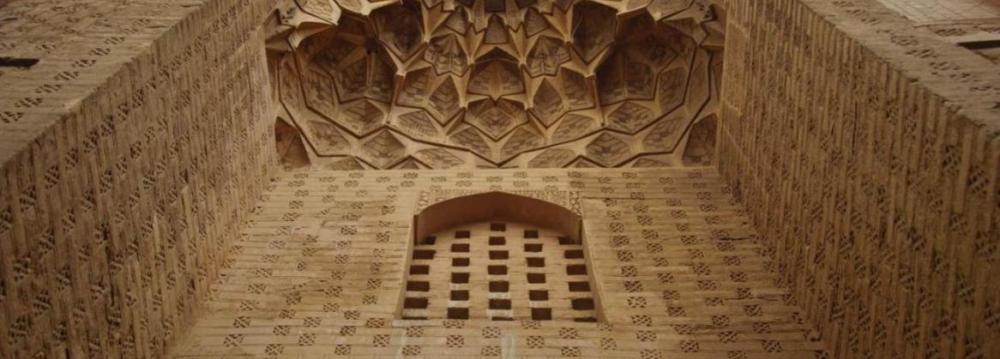Grand, simple, and old is the Jame Mosque (or Masjid Jame) of Naeen in Isfahan Province. It is in fact one of the oldest Islamic structures in Iran. Muslim or not, one is filled with awe when looking at its minaret rising high against the clear blue sky of the desert.
Unlike the other mosques originally built between the 7th and 9th centuries, Naeen’s Masjid Jame has seen only some minor changes and modifications, and it maintains its eminence from 1400 years ago.
The oldest part of the mosque dates back to the 7th century. Later additions in the 10th and 11th century make it more like a religious building complex, including a prayer hall, a pulpit, water reservoir, porticos, and corridors.
The mosque is on a square plan: a small central courtyard surrounded by porticos and prayer halls supported with short columns. In harmony with the desert weather, the building is made of adobe and fired brick. Not a single vault is left without a master’s touch, according to Naeen News Agency (nainna.ir).
Minaret
The minaret is at the southeastern corner of the mosque. It is 28 meters tall, and can be seen from a distance. Its octagonal cross section makes it completely different from other minarets in the province.
Mihrab
Naeen MasjidJame has a stuccoed mihrab, a semi-circular niche in the south wall which faces Mecca. The mihrab is finely carved in a dense floral design, and flanked by two decorative columns. The unique carvings of the mihrab are echoed on the 14 surrounding columns of the main hall.
Minbar
The congregational mosque has a famous minbar, an elevated pulpit where the preacher sits to deliver the sermon. The wooden minbar is 700 years old, with various intricate marquetries and carvings, pieced together to rise as high as five meters. Qur’an verses are carved on it in thuluth script. Since the wooden masterpiece is the most valuable minbar in Isfahan, it is protected with a fence, barring the access.
Underground Quarter
Beneath the courtyard, there is a network of rooms, cellars, corridors, and a prayer hall with a low ceiling. Two flights of stone steps lead to the underground prayer hall where temperature fluctuation is limited within a 10-degree range throughout the year. The underground quarter is a cool, refreshing resort in shimmering summers, and a warm shelter in winters.
Unlike the upper part, where every corner has been touched by skillful masons and craft masters, the hall, chambers, and the maze of passageways under the ground, were simply dug out of the ground.
The underground accommodation is cleverly lit by five marble slabs laid on the mosque’s floor. The marble panels curiously diffuse the daylight into stone ‘lampshades’.
The mosque had its own qanat water system that used to direct water from massive desert areas to a reservoir under the building.
Oldest Mosque
Naeen Masjid Jame provides ample space for spiritual reflection. There are many hidden recesses and alcoves for those seeking some calm and quiet solitude. Among other historical mosques in the country, the oldest are:
Masjid Jame of Toon in Ferdows town, South Khorasan Province, dating back to the 7th century.
Tarikhaneh Masjid in Damghan city, Semnan Province, dating back to the 8th century, when the half-ruined Sassanid fire temple was rebuilt and converted into a mosque.
Masjid Jame of Borujerd city, Lorestan Province, the oldest mosque in Zagros region and western Iran, built in the 9th century on a Sassanid fire temple.
The shrine of Imam Reza (AS) in Mashhad, Khorasan Razavi Province, with its initial domed building erected in the 9th century.
Shrine of Fatima Masumeh (peace be upon her) in Qom, dating back to the 9th century.
Masjid Jame of Ardestan, Isfahan Province, the first two-story mosque, with the oldest parts built on the site of a chahar-taq (4 vaulted dome) in the 9th century.
Masjid Jame of Qazvin, constructed on the orders of Harun al-Rashid, the fifth Abbasid caliph, in 807, with the last additions made in the Safavid era.
Shrine of Shah Abdol-Azim in Rey, Tehran, containing the tomb of Abdol-Azim, fifth generation descendant of Hassan ibn Ali (AS) dating back to the 9th century.


